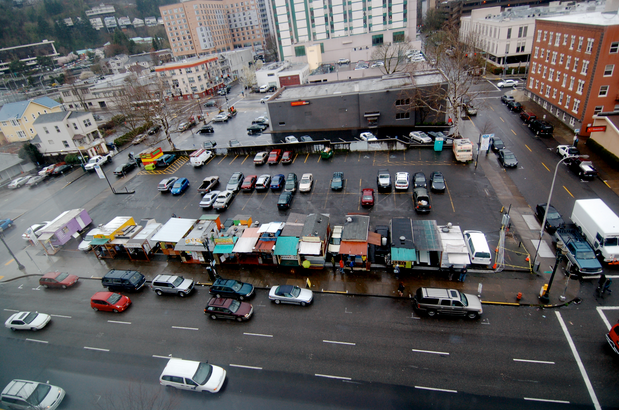 When I last worked in downtown Portland, twenty-some years ago, this was where I parked. Back then it was just a parking lot. Look at it now – the entire front row is occupied by food carts. It looks like a shanty town, but smells better. Driving by here a few weeks ago led me to think about the investing lessons that can be found in the incredible success of the restaurant business.
When I last worked in downtown Portland, twenty-some years ago, this was where I parked. Back then it was just a parking lot. Look at it now – the entire front row is occupied by food carts. It looks like a shanty town, but smells better. Driving by here a few weeks ago led me to think about the investing lessons that can be found in the incredible success of the restaurant business.
Individually, restaurants are notoriously fragile. They fail all the time. Collectively though, it’s the complete opposite. If we judged the success of an industry the same way we judge the success of a species, there’s no question that food service would be one of the top two or three in human history. There are millions of restaurants serving a bewildering array of food to people everywhere on the planet (including Antarctica). When one fails, others take its place. The industry constantly adapts to changing tastes, fads, innovations and technology. Some places draw you in and others bring food to you. Within a ten block radius of this row of food carts, you can find a place to spend anywhere from $5 to $500 on a meal. There’s a lesson here.
The vitality of the restaurant industry is a result of the fragility of the individual restaurant. It’s a decentralized collection of autonomous entities engaged in a constant experiment in trial and error. Any one of them could fail tomorrow and little would change. If McDonalds shuttered every one of their restaurants on Sunday, nobody would go hungry on Monday. Other restaurants would not topple in the wake of their closure. No government bailout would be necessary to save the industry.
This is a good model for investors. We can copy the anti-fragile nature of the restaurant industry by doing some of the same things:
- Decentralized autonomous holdings. Our portfolios are granular and diverse for a reason. Instead of three or four very broad, very large positions, we typically (when fully invested) have fifteen or more specifically focused positions within five or six primary asset classes. You can’t escape correlation completely, but specificity gets us closer.
- Allow failure. Losses are an inevitable companion of taking investment risk. Losses are also a necessary component of the trial and error process. The key is in not letting the error part hurt too badly. This is why we have a protective exit price on every holding and carefully manage position sizes.
- Don’t try to make something out of nothing. The restaurant industry is successful because each participant has an incentive to stack odds in their favor. They open new stores in populated areas. They serve food that people want at prices they are willing to pay. Those that try to buck the odds have a lower chance of success, so there are fewer of them. This accumulation of odds constantly accrues to the industry over time. Probability benefits an investor the same way. Given a large enough sample size, the success of an investment portfolio becomes a reflection of the odds of each individual decision.
- Benefit from evolution. Successful species adapt to their environment. The restaurant industry does this by adapting to the changing demands of the customer. The industry is not a conscious entity and doesn’t try to predict or shape demand, it evolves to suit it. Our investment portfolios do the same. Positions that don’t work are weeded out while those that do are allowed to run as long as demand is driving the price higher. Trend following doesn’t try to force anything, it simply allows a natural survival-of-the-fittest process to occur.
Entities that have survived and prospered for centuries leave a lot of clues. We would do well to pay attention.
Related posts:
Enjoy this post? Please subscribe now to be notified whenever a new article or free white paper is published.
Disclaimer: Past performance is not indicative of future returns. Information displayed is taken from sources believed to be reliable but cannot be guaranteed. All indices are unmanaged and investors cannot invest directly into an index. Ideas and opinions expressed in this article are the sole responsibility of Patrick Crook/PLC Asset Management and do not reflect any stated opinions of Commonwealth Financial Network, National Financial Services LLC or any other person or entity.